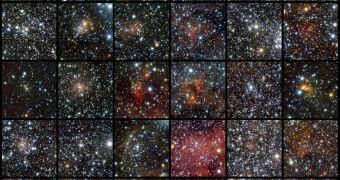Researchers working at the European Southern Observatory's (ESA) Paranal Observatory, in Chile, announce the discovery of 96 new open star clusters, previously hidden by massive dust clouds in our galaxy, the Milky Way.
In order to make the observations, experts surveyed the skies using the Visible and Infrared Survey Telescope for Astronomy (VISTA). The infrared capabilities on the massive instrument are what allowed astronomers to peer through the dusty veil surrounding these formations.
The new discoveries were made by an international team of astronomers, and the group asked for observations time on the world's largest survey telescope precisely because it is the only installation capable of conducting such in-depth studies.
Open star clusters at the core of the galaxy are very faint in comparison to other radiation sources, and the structures themselves are very small. However, this did not shield them from being discovered.
With this study, astronomers mark the first time so many faint clusters were discovered during the same observations campaign. The endeavor, named the VISTA Variables in the Via Lactea program (VVV), lasted only a year.
Details of the new research effort will appear in an upcoming issue of the esteemed scientific journal Astronomy & Astrophysics. In the paper, experts also explain how they were able to remove foreground stars from the view, so as to be able to count the objects inside each cluster.
“This discovery highlights the potential of VISTA and the VVV survey for finding star clusters, especially those hiding in dusty star-forming regions in the Milky Way’s disc. VVV goes much deeper than other surveys,” lead study author Jura Borissova explains.
“In order to trace the youngest star cluster formation we concentrated our search towards known star-forming areas. In regions that looked empty in previous visible-light surveys, the sensitive VISTA infrared detectors uncovered many new objects,” VVV Survey lead scientist Dante Minniti explains.
“We found that most of the clusters are very small and only have about 10–20 stars,” says team member Radostin Kurtev. The expert says that the newly-found clusters may in fact be just the tip of the iceberg when it comes to hidden structures in the galaxy.
“Compared to typical open clusters, these are very faint and compact objects – the dust in front of these clusters makes them appear 10 000 to 100 million times fainter in visible light. It’s no wonder they were hidden,” he says.
Open star clusters are widely considered to be the basic building blocks of galaxies. They are the locations were most stars with a mass more than half our Sun's appear and develop. They are generally located in very dusty regions of space.

 14 DAY TRIAL //
14 DAY TRIAL //